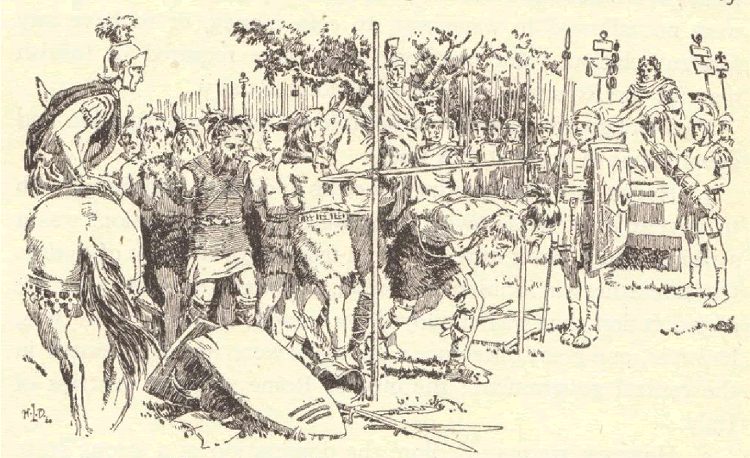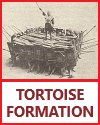Under the Roman Yoke: Ancient Romans compelling barbarian captives to pass under the yoke. Our English word subjugate is derived from the Latin words sub, "under," and jugum, "yoke." Click here to enlarge this image.
In ancient Rome, passing under the yoke, also known as jugum in Latin, was a humiliating and degrading punishment imposed on defeated enemy soldiers, particularly during the early period of the Roman Republic. It was a symbolic act that signified the complete submission and humiliation of the defeated soldiers.
Construction of the Yoke: A yoke was constructed by using two spears or planks placed vertically in the ground with a third one horizontally across the top, forming a triangular or A-shaped structure. The horizontal beam was often positioned at chest or neck height.
Passing Under the Yoke: The defeated soldiers, typically those who had been captured or surrendered, were forced to pass under this yoke as an act of submission and a display of their humiliation. They had to bend down or stoop to pass under the horizontal beam, symbolizing their defeat and subjugation.
Symbolism: Passing under the yoke was a public display of the vanquished enemy's loss of honor, freedom, and dignity. It was a way for the Romans to emphasize their victory and the complete submission of the defeated forces. It often served as a reminder to other potential adversaries of the consequences of challenging Rome's military might.
This practice was more common in the early Roman Republic and became less frequent as Rome expanded and faced different types of enemies. It was one of several forms of humiliation imposed on defeated enemies, along with confiscation of their weapons, the destruction of their fortifications, and sometimes enslavement.
As Rome's military campaigns extended further into the Mediterranean and encompassed diverse cultures and territories, Roman practices of dealing with prisoners of war evolved, and the passing under the yoke became less common. However, the symbolic act remained an important part of early Roman military traditions and was used as a demonstration of Roman power and dominance.
|















